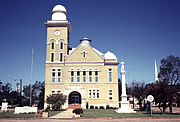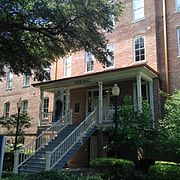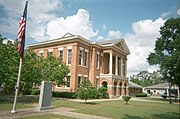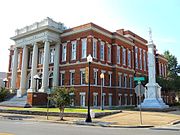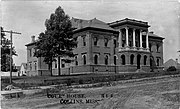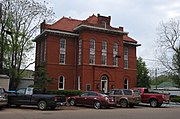
Sumner is a town in Tallahatchie County, Mississippi. The population was 407 at the 2000 census. Sumner is one of the two county seats of Tallahatchie County. It is located on the west side of the county and the Tallahatchie River, which runs through the county north-south. The other county seat is Charleston, located east of the river. Charleston was the first county seat, as settlement came from the east, and it is the larger of the two towns.

Samuel Sloan was a Philadelphia-based architect and best-selling author of architecture books in the mid-19th century. He specialized in Italianate villas and country houses, churches, and institutional buildings. His most famous building—the octagonal mansion "Longwood" in Natchez, Mississippi—is unfinished; construction was abandoned during the American Civil War.
Jefferson County Courthouse or variation prefaced with Old may refer to:

Frank L. Packard was a prominent architect in Ohio. Many of his works were under the firm Yost & Packard, a company co-owned by Joseph W. Yost.
Wilfred E. Mansur (1855–1921) was the most prominent architect in late 19th and early 20th century Bangor, Maine.

Proudfoot & Bird was an American architectural firm that designed many buildings throughout the Midwest region of the United States. Originally established in 1882, it remains active through its several successors, and since 2017 has been known as BBS Architects | Engineers.

John W. Gaddis was a noted architect of Vincennes, Indiana. He designed numerous buildings that are preserved and listed on the National Register of Historic Places.

Link & Haire was a prolific architectural firm in Montana, formally established on January 1, 1906. It designed a number of buildings that are listed on the National Register of Historic Places.

Keene & Simpson was an American architectural firm based in Kansas City, Missouri, and in practice from 1909 until 1980. The named partners were architects Arthur Samuel Keene FAIA (1875–1966) and Leslie Butler Simpson AIA (1885–1961). In 1955 it became Keene & Simpson & Murphy with the addition of John Thomas Murphy FAIA (1913–1999), who managed the firm until his 1980 retirement.
Patrick Henry Weathers, commonly known as P.H. Weathers, was an architect of Jackson, Mississippi.

Jefferson Davis County Courthouse is a historic county courthouse built in 1907 in Prentiss, Mississippi, the county seat of Jefferson Davis County. The courthouse was added to the National Register of Historic Places on November 10, 1994. It is located at the junction of North Columbia Avenue and 3rd Street.

George G. Adams was an American architect from Lawrence, Massachusetts.

Ernest C. S. Holmboe (1873–1954) was an American architect best known for his work in West Virginia.

John P. Eisentraut (1870-1958) was an American architect most closely associated with South Dakota. Eisentraut designed a number of buildings, including Carnegie libraries and courthouses, several of which are listed on the National Register of Historic Places. He was one of South Dakota's leading architects during the first quarter of the twentieth century.

The Pointe Coupee Parish Courthouse is a heritage listed courthouse on Main Street, New Roads, Louisiana, was built in 1902. It was listed on the National Register of Historic Places in 1981.
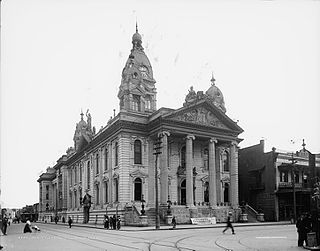
Rudolph Benz was an architect in the United States. He immigrated from Germany. He lived at 201 Rapier Avenue in Mobile. He was buried at Magnolia Cemetery
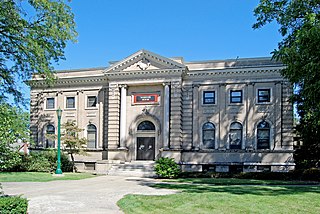
Penn Varney (1859–1949) was an American architect in practice in Lynn, Massachusetts, during the late nineteenth and early twentieth centuries.

Noah Webster Overstreet (1888–1973) was an American architect in practice in Jackson, Mississippi from 1912 to 1968.



